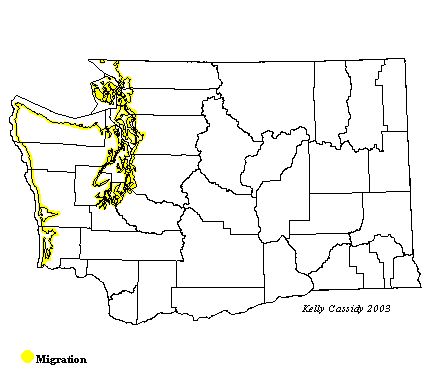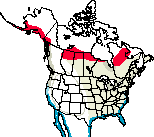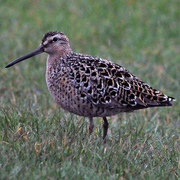Short-billed Dowitcher
General Description
The Short-billed Dowitcher is very similar in appearance to the Long-billed Dowitcher. Both birds are large shorebirds. In breeding plumage, they are reddish underneath and mottled-brown above. In flight, they show a pale trailing edge on their wings and a distinctive white blaze up their backs, which easily identifies them as dowitchers. The distinction between the two species is not as simple. The female of both species has a longer bill than the male, and the bill of the female Short-billed is the same length of that of the male Long-billed, so bill length can be confusing. Short-billeds in breeding plumage usually have some spotting rather than barring on the sides of their breasts in front of the wings. Long-billeds are usually barred. The belly of the Long-billed is typically reddish all the way back, and the Short-billed often has some white on the belly. Juvenile Short-billeds are brighter than Long-billeds, with light edging and internal rufous markings on the tertial feathers. Long-billed juveniles are drabber and darker than Short-billeds. Non-breeding plumage is very difficult to distinguish. Range, habitat, and vocalizations should all be used to help distinguish between these two species.
Habitat
During migration and winter, Short-billed Dowitchers are usually found in salt water on mud flats and tidal marshes. They can sometimes be found on fresh water at the muddy edges of ponds, but are less likely on fresh water than Long-billeds. They breed in open marshes and bogs in the boreal forest zone, usually inland, but close to fresh water.
Behavior
Short-billed Dowitchers can often be found in very large, dense flocks. They feed by probing their long bills into mud or shallow water. Their bills are full of nerve endings, useful for sensing prey. They walk along slowly, lifting their heads up and down like a sewing machine. The call is a sharp, low, two-syllable whistle, easily distinguished from the high peeping of the Long-billed.
Diet
On the breeding grounds, Short-billed Dowitchers eat insects and insect larvae. On mudflats, they also eat mollusks, crustaceans, marine worms, and other aquatic invertebrates.
Nesting
Short-billed Dowitchers nest in northern Canada and Alaska. Nests are usually located on the ground near water. The nest is a shallow scrape in a clump of moss or grass, lined with twigs, leaves, or grass. Both parents incubate the four eggs for about 21 days. The young leave the nest within a day of hatching and find their own food. Both parents help tend the young, but the female may abandon the group early. The male probably stays with the young until they are close to fledging.
Migration Status
Short-billed Dowitchers migrate medium to long distances. Many winter along the US, Central American, and South American coasts. The western race that passes through Washington stays close to the Pacific coast during its travels.
Conservation Status
Until 1950, Short-billed and Long-bill Dowitchers were considered a single species. The Canadian Wildlife Service estimates the population of Short-billed Dowitchers at 320,000, spread across North America as three subspecies. The same estimate numbers the western subspecies at 150,000 birds. The Short-billed Dowitcher is listed as a species of concern on the Partners in Flight watch list and is reported to be declining.
When and Where to Find in Washington
This common, coastal migrant may number in the tens of thousands in Grays Harbor during the spring migration peak. Willapa Bay is another major stopover point in spring. These two sites are the only spots where large numbers usually congregate in the spring, but smaller numbers may be scattered in other spots along Washington's outer coast as well. The spring influx of birds usually starts with a few birds at the end of March, and lasts into early May. They are common from early April to early May, peaking at the end of April. By mid-May, they have tapered off considerably and are rarely seen. By late June, they start becoming more common as the fall migration begins. The peak southerly movement of adults is from the end of June to mid-July, with numbers tapering off and blending into the August and early September peak migration juveniles. Numbers vary greatly, and in some years, fewer than a thousand birds are counted. The birds that migrate through Washington breed in Alaska and winter on the Pacific Coast south of Washington. Some first-year birds stay on the wintering grounds, or migrate only as far as Washington for the summer. Migrants in eastern Washington are never common. They can be seen occasionally in spring, and rarely in fall, at large wetlands in the Columbia Basin. While some birds summer at Grays Harbor and Willapa Bay, wintering birds are very unusual, and care should be taken not to misidentify Long-billed Dowitchers, which are much more common in Washington in winter.
 Abundance
Abundance
| Ecoregion | Jan | Feb | Mar | Apr | May | Jun | Jul | Aug | Sep | Oct | Nov | Dec |
|---|---|---|---|---|---|---|---|---|---|---|---|---|
| Oceanic | ||||||||||||
| Pacific Northwest Coast | C | C | R | C | C | C | U | |||||
| Puget Trough | F | F | R | F | F | U | R | |||||
| North Cascades | ||||||||||||
| West Cascades | ||||||||||||
| East Cascades | ||||||||||||
| Okanogan | ||||||||||||
| Canadian Rockies | ||||||||||||
| Blue Mountains | ||||||||||||
| Columbia Plateau | R | R | R |
Washington Range Map

North American Range Map


Family Members
 Spotted SandpiperActitis macularius
Spotted SandpiperActitis macularius Solitary SandpiperTringa solitaria
Solitary SandpiperTringa solitaria Gray-tailed TattlerTringa brevipes
Gray-tailed TattlerTringa brevipes Wandering TattlerTringa incana
Wandering TattlerTringa incana Greater YellowlegsTringa melanoleuca
Greater YellowlegsTringa melanoleuca WilletTringa semipalmata
WilletTringa semipalmata Lesser YellowlegsTringa flavipes
Lesser YellowlegsTringa flavipes Upland SandpiperBartramia longicauda
Upland SandpiperBartramia longicauda Little CurlewNumenius minutus
Little CurlewNumenius minutus WhimbrelNumenius phaeopus
WhimbrelNumenius phaeopus Bristle-thighed CurlewNumenius tahitiensis
Bristle-thighed CurlewNumenius tahitiensis Long-billed CurlewNumenius americanus
Long-billed CurlewNumenius americanus Hudsonian GodwitLimosa haemastica
Hudsonian GodwitLimosa haemastica Bar-tailed GodwitLimosa lapponica
Bar-tailed GodwitLimosa lapponica Marbled GodwitLimosa fedoa
Marbled GodwitLimosa fedoa Ruddy TurnstoneArenaria interpres
Ruddy TurnstoneArenaria interpres Black TurnstoneArenaria melanocephala
Black TurnstoneArenaria melanocephala SurfbirdAphriza virgata
SurfbirdAphriza virgata Great KnotCalidris tenuirostris
Great KnotCalidris tenuirostris Red KnotCalidris canutus
Red KnotCalidris canutus SanderlingCalidris alba
SanderlingCalidris alba Semipalmated SandpiperCalidris pusilla
Semipalmated SandpiperCalidris pusilla Western SandpiperCalidris mauri
Western SandpiperCalidris mauri Red-necked StintCalidris ruficollis
Red-necked StintCalidris ruficollis Little StintCalidris minuta
Little StintCalidris minuta Temminck's StintCalidris temminckii
Temminck's StintCalidris temminckii Least SandpiperCalidris minutilla
Least SandpiperCalidris minutilla White-rumped SandpiperCalidris fuscicollis
White-rumped SandpiperCalidris fuscicollis Baird's SandpiperCalidris bairdii
Baird's SandpiperCalidris bairdii Pectoral SandpiperCalidris melanotos
Pectoral SandpiperCalidris melanotos Sharp-tailed SandpiperCalidris acuminata
Sharp-tailed SandpiperCalidris acuminata Rock SandpiperCalidris ptilocnemis
Rock SandpiperCalidris ptilocnemis DunlinCalidris alpina
DunlinCalidris alpina Curlew SandpiperCalidris ferruginea
Curlew SandpiperCalidris ferruginea Stilt SandpiperCalidris himantopus
Stilt SandpiperCalidris himantopus Buff-breasted SandpiperTryngites subruficollis
Buff-breasted SandpiperTryngites subruficollis RuffPhilomachus pugnax
RuffPhilomachus pugnax Short-billed DowitcherLimnodromus griseus
Short-billed DowitcherLimnodromus griseus Long-billed DowitcherLimnodromus scolopaceus
Long-billed DowitcherLimnodromus scolopaceus Jack SnipeLymnocryptes minimus
Jack SnipeLymnocryptes minimus Wilson's SnipeGallinago delicata
Wilson's SnipeGallinago delicata Wilson's PhalaropePhalaropus tricolor
Wilson's PhalaropePhalaropus tricolor Red-necked PhalaropePhalaropus lobatus
Red-necked PhalaropePhalaropus lobatus Red PhalaropePhalaropus fulicarius
Red PhalaropePhalaropus fulicarius

